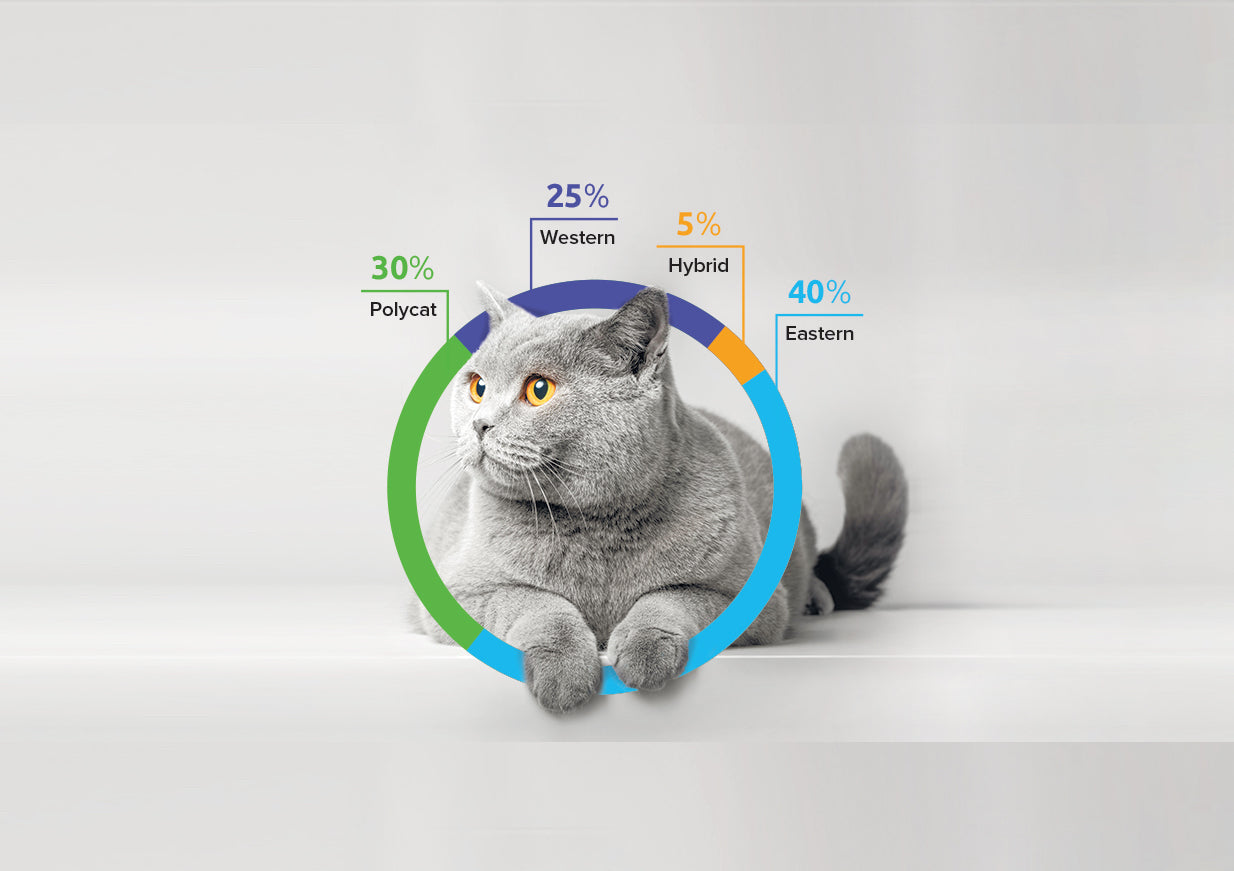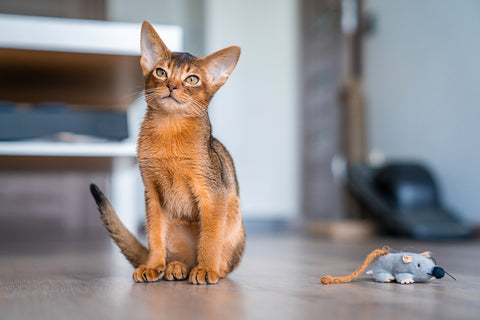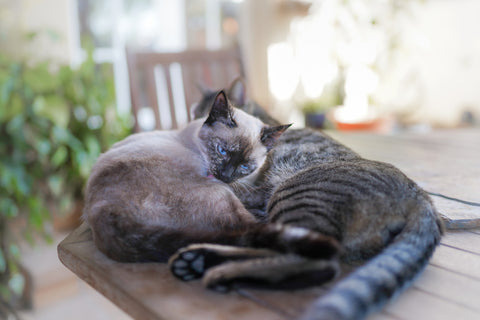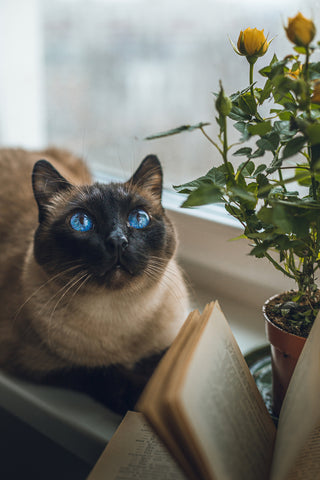
The breed analysis that you receive from a Basepaws Breed + Health Cat DNA test offers an exciting glimpse into your cat’s DNA story, yet much of it remains to be told. This includes a definitive story of ancestry, which is difficult to pin down for cats. In today’s post, we’d like to share some insight into why this is, and to explain the concept of genomic similarity that is at the heart of the Basepaws breed analysis.
History of Selective Breeding for Cats and Dogs

Let’s begin by reviewing the history of cat domestication and selective feline breeding and how it compares to that of dogs. As humans established agricultural settlements around 10,000 years ago, the need to protect crops from burgeoning rodent populations quickly became a priority. Adept at hunting these nuisances, cats proved essential to sustaining healthy crops.
- To maximize success for catching the most prey, it was advantageous to let cats “run wild” from one area of farmland to the next.
- This also meant that they were free to reproduce on their own terms with the other cats they encountered on their travels.
- Cats have an innate instinct to catch small prey; there is no need for humans to intervene in the process to, for example, increase the hunting prowess of the next generation.
While some cats elected to spend time with the humans who made a point to feed or care for them, many others did not. Those who did ushered in a type of feline “domestication” that was defined by a cat’s preference to have a relationship with a human, and not the other way around.
Eventually, human interest in cats shifted beyond an admiration of their natural abilities to manage small prey populations. The possibilities associated with a cat’s visually pleasing features became a point of focus, and in the 19th century people began experimenting with how to preserve existing aesthetic traits or bring about new ones in future generations of cats.
The practice of selective feline breeding, however, didn’t truly gain momentum until between 50-100 years ago. In contrast:
- The opposite is true regarding the domestication of canines and the history of canine breeding.
- Dog breeding has been a lot more complex and restricted than cat breeding and has occurred over many thousands of years.
- Relationships with dogs were driven by a wide range of specific human needs, which led to their earlier domestication and the establishment of selective breeding practices. To create offspring that could better perform a range of specific tasks such as guarding, hunting, driving/pulling, or herding, humans selectively bred dogs for the physical, behavioral, and aesthetic traits best suited to these tasks.
Implications for Breed Classification and Genetics Research

Table 1. Summarizes the differences between canine versus feline domestication, selective breeding, and genetics research. The millennia-long history of selective canine breeding means that time has allowed the specific traits that now characterize different dog breeds to become very well defined—both inside (genetically) and out (aesthetically).
With a broader, more diverse focus, the body structure and complex functional and behavioral features of selective dog breeding are known in genetics as polygenic traits. These traits are defined by the complex interactions of many different genes and combinations of gene variants. In contrast, aesthetic traits such as fur length and color are typically monogenic traits, which are defined by only a single gene variant.
- As such, the long history of selective canine breeding has led to well-established purebred dog breeds that are classified by both polygenic and monogenic traits.
- This extreme selective breeding has yielded more distinct genetic markers that help geneticists accurately identify the variations that make up one dog breed versus another.
The opposite is true for cats. The comparatively short timeline of selective feline breeding has not yielded the distinct genetic markers that geneticists use to accurately identify the variations that distinguish one cat breed from another. Feline genetics is also considered a nascent field of study, and it has historically been underfunded and underrepresented in science.
In summary, these factors have led to the analysis of a lot more dog genomes than cat genomes. An example of the difference in genome sequencing goals for cats versus dogs in genomics research helps to further illustrate this:
- Researchers from the 99 Lives cat genome project celebrated when they sequenced the genomes of 200 domestic cats (double their initial goal).
- The Dog10K Consortium aims to sequence the genomes of 10,000 dogs and wild canids, and to sequence all known dog breeds at high depth.
Beyond the 99 Lives project, there has been very little systematic effort to understand genome-wide differences between cat breeds. This is why Basepaws is committed to advancing feline genetics research and to expanding its feline genome database—currently the largest in the world—with the help of cat parents like you who participate in this effort by sending in your cat’s DNA sample for analysis and/or participating in our citizen science research programs.
The Basepaws Breed Analysis
Basepaws analyzes your cat’s genome and compares it to the genomes of the many thousands of cats that are in our purebred feline reference panel to find similarities. We work with modern purebred cat breeders to acquire our panel DNA samples and, to date, our reference panel includes the fully sequenced DNA of cats from 21 different breeds.
These breeds fall into four main breed groups: Western (from Europe and the Americas), Eastern (from Asia), Persian (Persian and related cats), and Exotic (hybrids and Egyptian Mau). These four breed groups contain genomes of representative breeds that share a high degree of genomic similarity and are more genetically distinct from other breed groups, i.e, they form their own clusters. You can view an example Basepaws digital report to see how we break down breed and breed group percentages that results from a breed analysis.
Basepaws is at the cutting-edge of feline genetics through its work to identify the common features—inside and out—of different cat breeds that are encoded within their respective genomes. As we analyze more and more cat genomes, we can better understand the genomic elements that are unique to each breed and analyze your cat’s genome against these elements to find similarities. As we grow our database and reference panel, Basepaws will periodically release updates to your cat’s original breed analysis report at no cost to you. This means that the Basepaws digital report is a “living” document that continues to share breed and health information with greater and greater accuracy.
Limitations to Cat Breed Analysis
The historically narrow focus on breeding cats for monogenically-defined traits, and classifying cats into purebred breeds based on these primarily aesthetic traits, means that we have a lot to learn in order to paint a clear and comprehensive picture of the distinct genetic markers that separate different purebred cat breeds from one another (and from unknown cat breeds).
This includes a deeper understanding of the genetic markers responsible for the more complex, polygenically-defined traits associated with behavior, predisposition to disease, physiological processes (e.g., metabolism), and more. To illustrate, let’s say that Basepaws gets a DNA sample from a cat that has been officially classified by a purebred breeder as a Scottish Fold. It is classified as such because it has folded ears—the monogenically-defined aesthetic trait that is symbolic of the breed. However:
- When Basepaws analyzes this cat’s genome as part of its breed analysis process, it is looking for genomic similarity between this cat’s genome and the many different genomes in our database.
- The results of the analysis may state that the top breed to which this cat’s genome is most similar is actually the British Shorthair. But how is this possible?
While the cat indeed carries the fold gene mutation responsible for the presentation of folded ears, our analysis reveals many more aspects hidden within the cat’s entire genome—and these happen to be overwhelmingly more similar to the genome of a modern-day British Shorthair. It turns out that the single gene variant responsible for the monogenically-defined folded ears trait only accounts for a tiny fraction of this cat’s overall genetic makeup.
Differentiating Genomic Similarity from Ancestry

Our modern-day cats rarely have ancestors of a defined breed, because the extremely short history of human-driven selective cat breeding has yet to overcome the much longer history of cats reproducing freely on their own.
Recalling the history of selective canine breeding versus selective feline breeding, the idea of what defines one dog breed from the next has been very stable over time, especially with older breeds.
- This has allowed for geneticists to have a higher confidence that a purebred dog breed has likely had an ancestor of that same breed in its family tree.
- Yet even with the long and well-defined history of dog breeding, this confidence is not absolute and much remains to be learned even about dog breeds and their ancestral lines.
With a short selective breeding history of only 50-100 years, the purebred cat is a very new concept. The feline genetic code has remained exceptionally diverse, even within purebred breeds. This means that most ancestors of cats are considered mutts. Another way to put it is that modern-day cats rarely have ancestors of a defined breed, because the extremely short history of human-driven selective cat breeding has yet to overcome the much longer history of cats reproducing freely on their own.
Using another example of breed results in a Basepaws digital report, let’s say that your cat’s genome is stated to be 45.7% similar to the British Shorthair. This does not mean that one of your cat’s direct ancestors was actually a British Shorthair. While it’s entirely possible that your cat does have a British Shorthair ancestor somewhere in their ancestral line, it is more likely that your cat’s genome is similar to the modern-day British Shorthair simply because of a shared common ancestor somewhere in their history that was probably a mutt.
Identical by State and Identical by Descent
All genetic tests, including the Basepaws Cat DNA test, are only able to confirm that matching DNA segments are “Identical by State (IBS)”. Using our example, the term IBS means that while your cat may share DNA segments with segments in the genomes of British Shorthairs in the Basepaws reference panel, it isn’t clear why they match. No genetic test can answer this question.

Shared DNA segments that are passed down directly from a known ancestor (e.g., a purebred British Shorthair cat) to the offspring are termed “Identical by Descent” (IBD). In the case of the British Shorthair, confirming IBD is especially complicated. An allele is considered IBD if, in two cats, a copy of the same allele has been inherited from the same parent, as opposed to the situation in which two identical alleles have not been inherited from the same parent, which would be IBS.
What Defines Descent?
The British Shorthair has been outcrossed with other cat breeds since World War II. This is because during World Wars I and II, food shortages drastically decreased British Shorthair populations and brought them close to extinction. To sustain some form of the breed, breeders chose to outcross the British Shorthair with Persian cats after World War II to grow the small population that was left while avoiding the detrimental effects of inbreeding.
Using this example, what defines British Shorthair descent? Is it British Shorthair cats with family trees that can trace other British Shorthair ancestors of the pre-World War II breed, or does the ancestral line not begin until after World War II once the breed was outcrossed with Persians? Once a decision is made, how would one then determine whether a shared DNA segment was Identical by Descent?
It turns out that it isn’t possible to determine. The only thing that genetic testing can do is compare genomes to modern day representatives of a category of interest (in this case, the British Shorthair breed), and make assumptions based on this comparison.
- The confidence of the interpretation depends on the breeding history of the species, so Basepaws only uses purebred DNA from certified cat breeders of modern-day representatives of purebred British Shorthairs that are registered with specific cat breeder’s associations that have British Shorthair breed standards.
- We look for DNA segments that your cat shares with the DNA of modern-day British Shorthairs in our reference panel (as well as all the other breeds in the panel).
- Due to the complicated history of most purebred cat breeds and the fact that we do not have fully sequenced DNA from all members of your cat’s family tree and the family trees of all British Shorthairs in our panel, we cannot identify DNA segments that are Identical by Descent through ancestral lineage.
Therefore, a result of 45.7% genomic similarity to the modern-day British Shorthair should not be interpreted as meaning that your cat is part British Shorthair, or that it has a British Shorthair ancestor. Although it is possible in theory, this interpretation is less likely to be the correct one, given the fact that most modern-day cats do not have purebred ancestry. A much more likely interpretation is that your cat and representatives of the modern-day British Shorthair breed did, at some point in time, share a common non-purebred ancestor and this is what gave rise to the genomic similarity results we observed.
Advancing Feline Genetics with the Basepaws Community
Cat parents in the Basepaws community are integral to the work we’re doing to elevate feline genetics and make new discoveries that have the potential to improve the health, wellness, and longevity of cats everywhere. Thank you for being a part of this pioneering journey—we couldn’t do it without you! Don’t forget to review our current list of ongoing Basepaws citizen science research programs. Your cat’s DNA has the potential to help us make a real difference in the lives of cats, now and in the future.
We hope that this blog (one of our longer ones, we know!) has provided deeper insight into the Basepaws Cat DNA test and its focus on genomic similarity, as well as into some of the historical and current challenges behind cat breed identification and an ability to provide a definitive story of feline ancestry. As always, if you have any questions, we’d love to hear from you! Email us anytime at meow@basepaws.com.



